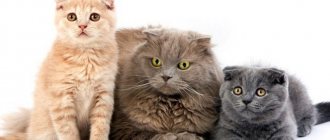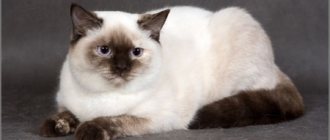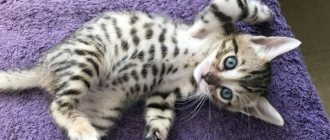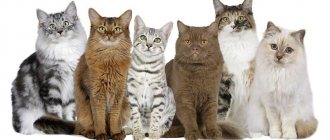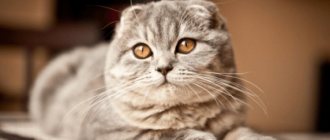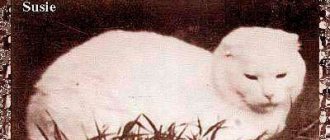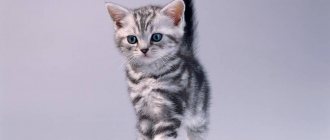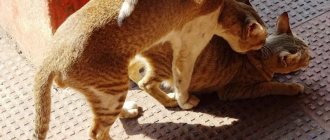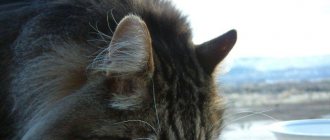It is difficult to argue with the fact that cats are currently the main favorites of the planet. Scottish cats had a hand in achieving this status.
This is a relatively new breed, the history of which goes back about 50 years. The first cat with floppy ears was discovered in Scotland, but for a long time this appearance was considered a defect. Despite the fact that people immediately appeared who appreciated the unique appearance, the breed was denied existence for a long time.
It’s hard to argue with the fact that cats are currently the planet’s main pets.
Everything was decided when Scottish fold cats appeared in the United States, where they became very popular. By 1980, breed standards were established, after which breeders around the world began to strive to breed a certain type of cat. The modern name for the Scottish Fold also appeared.
Plain (solid, solid)
The monochrome uniform coloring of Scottish cats is considered classic by breeders. The solid or solid color of the animal implies the absolute exclusion of any inclusions, small marks and specks of a different color. The tone is rich, even along the entire length of the coat.
The most common used to be considered blue plain Scots. But today among the representatives of the breed there are many other variants of solid colors.
White
A Scottish cat with snow-white fur (without yellowness) looks luxurious. Possible eye colors are blue, amber, copper. According to the standard, eyes of different colors are allowed. The paw pads and nose are light pink.
Kittens may have markings of a different shade, which disappear after the first coat change. By the age of two, the coat of a white Scot should be crystal clear, without spots of a different color.
Black
The black cat has expressive yellow eyes. The nose and paw pads practically blend into the main color of the animal.
On the shiny bright coat of the Scottish beauty Ebony, 2-3 hairs of contrasting white color are allowed. The presence of large red or brown marks is not provided for by the standard.
Important: Scottish Fold pets are endowed with magical abilities. It is believed that it is the black color of the Scottish Fold that protects the house and its inhabitants from evil spirits.
Chocolate
The brown Scottish cat, also called chocolate, looks noble and impressive. The color of the coat contrasts with the animal's yellow, golden or copper eyes. The nose and paw pads are also dark brown.
Lilac (lavender)
The monochromatic lilac Scottish Fold has a gentle gray tint that smoothly turns into cream. The nose is slightly brownish, the paws on the bottom are the same color as the coat, in harmony with the main color of the pet. This lilac-lavender color goes well with eyes of copper, amber or orange shades.
Red (red)
Red or ginger color is a rare and valuable color of the Scots breed. The fiery edge is combined with burning amber irises. Pads and nose to match the dominant color.
The tail of kittens and adult animals is not very evenly colored. This deficiency does not disappear with age and is allowed by the standard. And the presence of marks on the head and limbs that remain after reaching the age of two are considered a deviation from the norm.
A red Scottish straight-eared cat can give birth to kittens not only with erect ears, but also with ears pressed to the head.
Cream
The cream or peach fold cat is infinitely elegant and beautiful. The delicate background of light fur, bright golden eyes and a pinkish nose give the pet an irresistible appearance. The pads on the paws are also pink. An animal with this color is similar to a red Scotsman, but its coat color is a shade lighter.
A peach fold kitten may have a blurry, fuzzy pattern on its paws and tail that does not disappear with age. This is not critical for a purebred pet, but leopard markings are absolutely unacceptable.
Faun (deer)
There is another unique color of Scottish fold cats with an interesting name - fawn, which means “young deer”. The nose and pads on the paws of these beauties are beige-pink.
Cinnamon
Cinnamon is a lighter and more delicate color than chocolate, but darker than red. The nose and paw pads of such animals are brown, beige or pink.
Blue color (blue)
The gray or blue Scottish cat has very beautiful amber eyes. The coat tone of a purebred pet can belong to any range of gray - from the lightest (blue) to completely dark (blue). At the same time, each hair is saturated and well colored, without streaks.
The nose and pads practically do not differ in color from the plain coat.
A gray Scottish Straight cat may be marked with a few streaks and drawings in childhood. But as they grow older, these color flaws go away.
Personality of the Scottish Straight cat
The Scots are similar in character to the British. These are calm, balanced cats that are difficult to anger. However, among them there are also restless ones who are ready to chase a fly all day. But in most cases, Scottish cats prefer to snore peacefully in a secluded corner rather than rush around the apartment.
The Scottish Straight is a proud and serious cat that does not tolerate total control from its owner. Don't expect that you will allow yourself to be squeezed or held on your lap. The cat will come to you for a portion of veal tenderness whenever he wishes. It is worth noting that the Scots are by no means hermits, they simply require a little more personal space compared to representatives of other breeds and do not like it when people interfere in their cat’s affairs.
The peak activity of Scottish cats is observed in the first year of their life. Kittens are restless and playful to a fault, and adult male cats are known for their exemplary behavior and restraint.
Straits easily tolerate loneliness, but only for a short time. They will most likely even be glad that the owners left the house for a few hours and left them alone. However, prolonged separation from humans negatively affects the character of these cats. They become capricious and grumpy, and may even take revenge for the long absence of their owners. Some owners tell how their purrs suddenly begin to shit past the tray or rummage in flower pots, although they previously demonstrated exemplary behavior.
Straight-eared Scottish cats, in moments of special tenderness for their owner, turn on their soothing quiet motor and massage with their paws, burying their nose in the neck area. At the same time, it is impossible to predict in advance when a cat will bestow this mercy on a person. Moreover, they do this not with all family members, but only with those whom they love and respect. Most likely, such a favorite will be the one who feeds the “Scottish king” on time, does not scold him, allows him to sleep in the bed and does not bother him over trifles.
Scottish cats welcome strangers and guests generously - without aggression or unnecessary suspicion, but they also do not demonstrate violent delight.
Scottish Straight cats are emotionally stable animals that are not subject to mood swings. However, behavior in the style of “the most disgruntled cat in the world” occasionally slips through. In addition, representatives of the breed are characterized by amazing persistence. If they want something, they will definitely achieve it. The cat will follow the owner wherever he goes and accompany him with annoying meows.
The Scots do not try to pull the blanket over themselves when it comes to the distribution of roles between other pets. Cats are loyal to dogs, to their relatives, and to small rodents.
Representatives of the breed easily learn the rules of etiquette. They clearly understand that wallpaper and sofa upholstery cannot be torn if the owner has forbidden it, and they feel a person’s dissatisfaction subtly. Cats are quite stress-resistant and quickly cope with changes in environment.
Many Scots are extremely passive. They prefer to watch what is happening from the side, for example, sitting on a sunny windowsill. Sometimes it seems that they are immersed in their thoughts and do not notice what is happening under their noses.
Favorite toy: feather teaser. Cats can chase such a treasure for hours.
Interesting. Scottish cats need tactile contact with a person, but at the same time they do not like to be picked up.
Training and education
There are almost no problems with raising Scottish cats. It is not difficult to accustom a Straight to a scratching post and a tray; the main thing is to start from infancy and act gently but persistently. Often, it is enough to take the baby to the tray several times for him to understand where to relieve his physiological needs. If your kitten makes a puddle on the floor, take a piece of toilet paper and place it in the litter tray. The baby will smell his own urine and understand where to go.
You can’t poke a prankster into a puddle, much less beat him. This behavior of the owner will cause aggression and a desire to do mischief out of spite. But this kitten will hide safely.
Experts do not advise training straights, they do not like it, especially since unquestioning obedience is not in their character. Show-class individuals can master the training program. In the future, they will be able to demonstrate their skills at exhibitions.
If a cat violates the boundaries of what is permitted, stop it with the command “No!” Say it in a loud and stern voice.
If the baby does not obey, lift him by the withers and imitate a cat hissing. The kitten will understand this language faster.
If your pet tries to steal food from the stove or table, clap your hands loudly to scare it away.
If your cat gets into the habit of digging in pots or chewing flowers, spray him with water from a spray bottle.
Don't scold or praise your pet after the fact. Despite his developed intelligence, he is not able to connect yesterday's exemplary behavior and today's encouragement.
Two-color
A unique coat color is bicolor (two-color cats). The main background is snow-white. The second color in color (cream, black, blue, red) is presented in the form of unusual patterns. Thoroughbred representatives must have white belly, neck, chest, paws, muzzle and beard.
A prerequisite is the predominance of a white background in color. Bicolors are more valued; their body patterns are symmetrical. The eyes can be any shade, but are usually blue or golden yellow.
Cream bicolor
Cute white cats with additional streaks of delicate cream tones. The eyes are blue or yellow, and the nose and pads are pink.
Blue bicolor
The pattern on the wool is blue (delicate or rich gray). The iris of the eyes is a beautiful sky tone or yellow-orange. The nose and paws below are pink.
Black bicolor
Black and white bicolor is characterized by patterns of rich black tone. These cats have a pink nose and blue or copper eyes. A symmetrical, distinct pattern on the skin turns the cat into a real gentleman in a tailcoat.
Breeding
Sexual maturity in Scottish beauties occurs at 8-10 months, but the first mating is carried out no earlier than 1.3 years. Early mating often results in protracted labor and death of the offspring, and in males it leads to a shortening of the fertile period.
The first heat of cats occurs after a year. She needs to be passed and mated for the second or third heat.
The intervals between estrus vary and depend on the season. Breeders have noticed that purebred cats have much fewer periods of heat throughout the year than domestic cats.
The breeding partner must be selected in advance, following the rules established by the WCF. Ideally, the cat should be the same color as the female cat. It is not recommended to mix chinchilla with tabby, blue with lilac, etc. From such unions, kittens are born with uneven color or an indeterminate iris color.
Folds are mated exclusively with straights! The cat is brought into the cat's territory on the second day of estrus. First, the couple gets acquainted, the male courtes his lady with all his might, and the female explores the territory. The success of mating largely depends on the cat. Some very impressionable “grooms” are at a loss from the “bride’s” aggression, others do not even blink in response to the evil hiss.
The couples meet in a civilized manner. For some time, it is better to keep the animals on opposite sides of the door. This way they will receive information in doses. As soon as the partners get to know each other, the barrier between them can be removed. The duration of the mating itself should not exceed three days. Pregnancy lasts 9 weeks. After mating, the female becomes very calm.
The first signs of pregnancy appear after 2-3 weeks: the nipples turn pink and swell. At week 5, the belly is rounded and weight gain is observed. You need to prepare for childbirth in advance: buy disposable diapers, scissors for cutting the umbilical cord, disinfectants. You can also schedule the birth with your veterinarian, especially if your cat is giving birth for the first time.
Color point
Color-point is translated from English as “colored point”. The point coloring is explained by the presence of a gene, under the influence of which the coloring of hairs intensifies in some areas of the body with insufficient blood circulation. Characteristic darkening appears on the main white or cream background of the coat.
The second name of the color is Point Links. The eye color of cats of this color is necessarily blue. Previously, this coat color was observed only in the Siamese breed. But today it is present in other cat species, including Scots.
Newborn kittens are completely white. Only by the age of one month do babies begin to show color on their ears, paws, tail and face. According to this color, several subspecies are distinguished among the points.
Blue Point
This color is characterized by a pale gray-blue, almost white shade of the body with darker, gray markings. Soft gray Scottish blue point kittens have paws and noses that match the main color.
Cream point
The body is creamy white, and the shading on the animal’s face and tail are pastel cream colors. Paw pads and nose are pink. This point color goes harmoniously with the expressive blue eyes of the cat.
Lilac Point
The dominant tone is soft white or lilac, and the markings are gray with a pink tint. The nose and paws are the same as the main color.
Seal Point
The darkest color among the points. The dominant tone is beige. Contrasting with it are brown and black markings. The same dark nose button and paw pads.
Chalklit Point
Chocolate or choclit point is distinguished by a brown pattern on a cream background. Paw pads and nose range from light cocoa to darker brown.
Red point
The main coat color is pale apricot, almost white. Darkening on certain parts of the body is red-red in color. The pads and tip of the nose are bright pink.
Pattern color combination
Each pattern has its own variations of contour and base shades. All tabby cats have copper, orange, yellow, and brown eye colors:
| Name | Picture color | Background | Eye rim color |
| Silver | Black, dark | White, light | Blue |
| Blue | Grey | Cream, light | Blue |
| Black silver | Jet black | Silver | Blue |
| Chocolate | Chocolate | Cream | Brown |
| Brown | Black | Silver with golden shimmer | Brown |
| Bronze | Brown | Cream | Brown |
| Caramel | Light brown | Light beige | Brown |
| Cream | Rich cream | Delicate cream | Dark pink |
| Lilac | Lilac | Silver-lilac | Lavender |
| Red | Fiery red | Pale red | Dark red |
| Peach | Brown with pink tint | Cream | Dark pink |
Tortoiseshells (torties)
The tortoiseshell color of Scottish Folds is usually tri-colored. Red, white, and black spots are located on a cream or red dominant background. When the genes of the parents are combined in a tortoiseshell kitten, these markings can take on chocolate, blue and cream shades.
When assessing tortoiseshell cats, felinologists pay attention to the even distribution of markings and the intensity of their tone. Fold-eared and straight-eared Scots with a tortoiseshell color are divided into subspecies (depending on the color scheme of the spots).
Black-red
There are black and red-red patterns all over the cat's body. The sizes and shapes of the spots are very diverse. This color is often called tortie.
Chocolate red
The patterns on the wool are brown and red. They stand out against a lighter background and look very interesting. The chocolate red color is considered rare and prized by breeders.
Blue-cream
The tortoiseshell blue-cream color in Scottish pets is determined when the main gray-blue background is covered here and there with small light cream spots.
Important: tortoiseshell coloring is characteristic only of cats. The calico cat is very rare. The appearance of a male tortoiseshell kitten indicates genetic problems. Most likely, an adult pet will not be able to have offspring, since the reproductive functions of its body are impaired.
Color table
The international classification also applies to Scottish cats. The table is used to compile a description of colors that rarely appear in the population. The table contains an alphanumeric code, in which XXX is the designation of the breed, and lowercase xx is the main color. Numbers from 01 to 35 indicate the color variant.
Table of main colors
| Code | Decoding the code |
| a | blue |
| b | chocolate |
| c | lavender |
| d | red |
| e | cream |
| f | tortoiseshell (black) |
| g | tortoiseshell (blue) |
| h | tortoiseshell (chocolate) |
| j | tortoiseshell (lilac) |
| m | caramel |
| n | ebony |
| o | honey |
| p | beige |
| s | silver |
| t | amber |
| w | white |
| y | gold |
| X | unregistered color |
Smoky (smoky, tuxedo)
The color of Scottish Fold cats can be smoky. On top the coat is one color, for example black. And at the base, each hair is silvery-white. This coloring is characteristic of cats with a dominant silver gene, which creates unusual combinations of light and dark shades.
Smoky color is easy to confuse with solid color. To avoid mistakes, you just need to look at the undercoat. With a smoky color, the undercoat of a different shade is clearly visible, and with a solid color, the color of the roots does not differ from the tips.
The eyes of smoke cats are usually yellow-gold in color. Based on the shades of smoke on the fur, several subspecies of this color of animal are distinguished.
Blue smoke
Smoky blue Scottish Straights and Scottish Folds are distinguished by the color of their fur coat with a gray cold coating. But underneath the fur is white and silvery. The paw pads and nose of these pets are gray-blue.
Black smoke
This color in Scottish cats is characterized by a black edge, but the hair at the roots is white. The nose mirror and pads do not differ from the main background.
Chocolate smoke
The snow-white undercoat is combined with a brown-chocolate topcoat. The nose button and paw pads of these animals are brown in color.
Smoky Scottish Straights and Scottish Folds, despite their unique color, cannot participate in exhibitions. Such cats are not recognized by the breed standard.
Peculiarities
The discoverer of the Scottish Fold breed is rightfully considered the Scotsman William Ross, who noticed kittens with an unusual coloring and strangely shaped ears from a farmer he knew. To obtain new, more diverse types of coloring, the Scottish breed was first crossed with others.
Interspecific crossings occurred especially often with British cats . However, now representatives of the Scottish Fold breed have all the necessary genes to reproduce almost any color , so in our time, crossing a purebred Scottish Fold with other breeds is very, very undesirable.
Like other animals, in Scots a certain set of genes is responsible for coloring. There are two predominant shades: red and black . Each of the colors, or, more precisely, certain genes responsible for a specific color, can be both dominant and recessive. The saturation of a certain shade of fur, which is formed by the diluent gene, depends on this.
A very unusual genetic combination in white cats. Two cases are possible: either a complete absence of color, or suppression of other genes . In this regard, white Scottish cats are divided into albinos and dominant white.
Remember that kittens' colors will change as they grow older. A Scottish kitten will reach its real, “adult”, full color only at the age of two years.
Tabby colors
Scottish tabby cats are very popular among breed lovers. This color suggests the presence of patterns on the pet’s fur.
Depending on their shape and size, tabbies are divided into three types:
- Striped (tiger) color - the presence of clearly defined vertical stripes.
- Spotted (leopard) - the pattern is made up of spots on the animal's fur.
- Marble color is a pattern of larger chaotic marks of different shapes.
A prerequisite for tabby cats is the presence of the letter “M” on the top of the animal’s forehead. The color combinations of wool are surprising in their diversity:
- cream;
- golden;
- blue;
- marble on silver;
- black marble;
- silver;
- silver-blue.
Important: Scottish tabbies with a silver tabby color resemble the mustachioed pet from a cat food commercial. Many believe that it is the Scottish straight-eared cat with a tabby pattern that appears on the screen. This color is also called the whiskey color of Scottish cats.
Variety of tabby colors in Scottish and other breeds of cats: how not to make a mistake with your choice?
The English word “tabby” means “striped, varied.” In the modern lexicon it is mostly used in relation to the coat color of cats. The natural color tone is determined by the initial conditions of their habitat. Thanks to this coloring, cats hid from attacks behind grass and trees. Over time, people began to domesticate cats and developed many shades and lengths of fur. Today there are approximately seventy new breeds. However, the color scheme remained the main one.
Chinchilla
The Scottish chinchilla borrowed the extravagant colors of its coat from the British, and they, in turn, from Persian cats. A chinchilla kitten is born only from parents with an unusual color. Each hair is colored in two colors.
Most of it is light in color and 1/8 of it (the top) is dark in color. This phenomenon is called tipping.
Tipped chinchilla colors can be of 3 types:
- Golden. The cat has a white undercoat. But on top there is a reddish coating over almost the entire surface of the body (on the sides, back and tail of the animal). Only the beard, the tips of the ears and the belly are white. Yellow-gold eyes, pink pads and a brick-colored nose.
- Silver. White wool coated with silver gives an interesting gray effect. The color of the tail has a hint of stripes, the nose is beige, and the eyes are green. Snow-white tips of the pet's ears, chin and belly.
- Blue golden. The rarest and therefore valuable color of Scottish chinchillas. The undercoat is a delicate caramel color, and the tips of the hair are a radiant blue hue. The eyes are natural emeralds of a rich green tone.
How to choose a kitten
Scottish straight kittens are just as adorable as fold kittens. Before buying a baby, study the breed standard and choose a nursery with a license to breed Scots.
Healthy Scottish cats smell pleasant, have lush and shiny fur, clear expressive eyes, a soft, non-bloated belly, and clean fur under the tail.
Trouble-free kids willingly join in the game and show a keen interest in strangers. Lethargic kittens are most likely sick with something.
Observe the character of the parent couple. This will help you understand what traits the kittens will inherit.
Shaded (shedded) colors
An unusual definition refers to the interesting color of Scottish cats - shaded colors. These pets have almost white fur, but the tip of the guard hair is colored.
The top layer of a cat's coat can be any shade typical of Scottish cats. The undercoat is white. The sides, back, head, tail and ears are shaded. Light belly, chin and lower tail. There should be no obvious spots. The “M” sign on the forehead and darkish rings on the paws are acceptable.
Shedded colors can be of three varieties:
- Golden. The fur of the Scottish cat is golden, the undercoat is cream or light peach. Green eyes are very expressive and beautiful. The nose button and paw pads are chocolate.
- Red. This type of shaded color has a dark red coating on the coat with a snow-white undercoat. The eyes are amber, the pads and nose are pink.
- Silver. The white undercoat combined with the dark gray topcoat produces an amazing gray tint. Greenish eyes are lined with black stripes. This feature is typical only for the silver shedded color. Other varieties have eyes without a contour. The nose is brick-colored and the mouth is dark-lined.
Genetics and origin history
The tabby coloring is influenced by genetics, namely the “A” gene. He belongs to the super dominant group. He dyes his mustachioed friend's fur in a special way, alternating different tones.
Due to the dark pigment, some areas are more clearly defined. On light areas of the coat, the effect of alternation creates less contrast, which looks original and beautiful. A striking example of this is the Asian red tabby.
Initially, all kittens develop a color according to their genotype, then the “childish” color disappears and their characteristic color appears.
Studies have shown that the spots and stripes on the pets are similar in appearance to the Asian, African and European wild cats.
Interesting facts about Scottish Folds
- Unlike most cats, Scottish Folds do not like heights and are afraid of them. The reason is the peculiarities - the atypical structure of the vestibular apparatus
- The Scottish Fold is a sociable cat. Her speech bears little resemblance to a cat's purring. It's more like cooing. Her voice is quite low, with a slight hoarseness.
- The Scottish Fold loves to sit and lie in positions uncharacteristic for cats. He often sits on his hind legs, hanging his front legs and listening to what is happening in the house. The Scottish Fold can be found sleeping on its back, with its paws spread out to the sides.
- The first cats with floppy ears date back to 1793. Their homeland is China. It is believed that the ancestor of the ancestor of the breed, Susie, was one of the Chinese fold cats brought from the Middle Kingdom to the British Isles.
- Scottish Folds are considered one of the easiest cat breeds to care for.
Potential Health Problems
The mutated gene, unfortunately, has caused Scottish Folds to be prone to diseases of the musculoskeletal system. Osteochondrodysplasia is most often diagnosed in Scottish Folds. This is a severe hereditary disease characterized by pathology in the development of bone tissue and joints. The main symptoms are lameness, stiffness of gait, soreness of the tail tissues, dwarfism. The disease is rarely fatal, but can lead to serious motor impairments, including complete immobility of the Scottish Fold.
Among hereditary diseases, the Scottish Fold is diagnosed with cardiovascular pathologies, entropion of the eyelids, glaucoma, and polycystic kidney disease. They appear mainly in animals aged 7 years and older.
The ears of the Scottish Fold are susceptible to infection, infestation with ear mites. They should be inspected and treated regularly.
The Scottish Fold needs timely vaccination to help protect against major infectious pathologies, treatment for skin parasites, and deworming. It must be protected from drafts and hypothermia.
